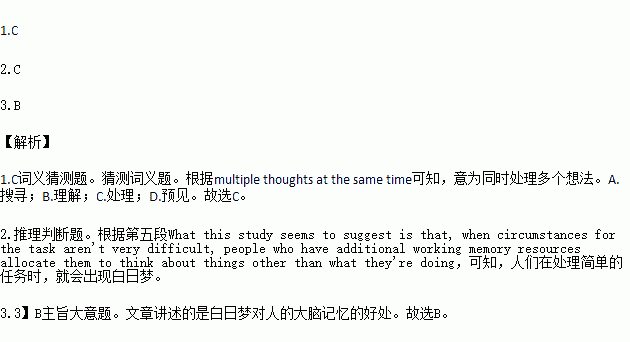题目内容
Catch yourself daydreaming while washing the dishes again? If this happens often you probably have a pretty capable working memory and a sharper brain, new research suggests.
This mind wandering, it seems, actually gives your working memory a workout. Working memory is the mental work space that allows the brain to juggle multiple thoughts at the same time. The more working memory a person has, the more daydreaming they can do without forgetting the task at hand.
Researchers studied groups of people from the University of Wisconsin-Madison community, ranging in age from 18 to 65. The volunteers were asked to perform simple tasks, like pressing a button every time they took a breath or clicking in response to a letter popping up on a computer screen; these tasks were so easy that their minds were likely to wander, the researchers figured.
The researchers checked in periodically, asking the participants if their minds were on task or wandering. When the task was over, they measured each participant's working memory capacity by having them remember letters while doing math questions. Though all participants performed well on the task, the researchers noticed that the individuals who indicated their minds had wandered more than others also scored higher on the working memory test.
“What this study seems to suggest is that, when circumstances for the task aren't very difficult, people who have additional working memory resources allocate them to think about things other than what they're doing,” said Jonathan Smallwood, a study researcher of the Max Planck Institute for Human Cognitive and Brain Science.
When our minds run out of working memory, these off-topic thoughts can take the main stage without us consciously meaning them to; for instance, arriving at home with no memory of the actual trip, or suddenly realizing that they've turned several pages in a book without understanding any of the words.
“It's almost like your attention was so absorbed in the mind wandering that there wasn't any left over to remember your goal to read,” study researcher Daniel Levinson, said in a statement. People with overall higher working memory were better able to stay focused when the task at hand required it. Those who had low working memory often had their thoughts drift away from the task, and did less well at it.
The findings add to past research suggesting these mind drifts can be positive moments. For instance, daydreaming has often been associated with creativity—researchers think that our most creative and inventive moments come when daydreaming. It's likely that the most intelligent among us also have high levels of working memory, Levinson noted.
1. The word “juggle” in the second paragraph can be replaced by “________”.
A. search B. understand C. handle D. foresee
2.What can be concluded from Jonathan Smallwood's words?
A. Absorbed in the mind wandering, your attention left no space for your goal.
B. On the working memory test, people with wandering minds will get high score.
C. Dealing with some easy jobs, people with higher working memory will daydream.
D. People who often have daydreams probably own a pretty capable working memory.
3. What is the best title of the passage?
A. Mind drifts are always positive.
B. Daydreaming is good for the mind.
C. Creative moments come with working memory.
D. The more daydreaming, the more effectively one works.
Table 1: Major Agricultural Products
Product | Output(产量) 2011 ( 1 million tons) | Increase over 2010 (%) |
Grain | 492.5 | -2.4 |
Oil-bearing crops of which: Peanuts(花生) Rapeseed(菜籽) | 21.5 9.62 9.54 | -2.8 -5.1 3.7 |
Cotton | 4.3 | 2.4 |
Tea | 0.61 | 3.4 |
Fruit | 50.45 | 8.4 |
Meat of which: Pork, beef and mutton | 53.54 41.21 | 8.0 8.0 |
Cow milk | 6.63 | 5.4 |
Sheep wool | 0.29 | -1.4 |
Silkworm cocoons | 0.5 | -2.7 |
Aquatic(水产)products Of which: Fresh water Marine (海) water | 35.61 14.26 21.35 | 8.3 11.8 6.1 |
Table 2: Major Industry Products
Product | Output 2011 | Increase over 2010(%) |
Cloth | 22 billion meters | 5.2 |
Sugar | 6.8 million tons | 6.3 |
Cigarettes | 34.02 million cases | 0.0 |
Color TV sets | 26.43 million sets | 4.2 |
Household refrigerators | 9.86 million | 0.7 |
Total energy production Standard coal | 1.34 billion tons | 0.7 |
Coal | 1.39 billion tons | 0.0 |
Electricity | 1,132 billion kwh | 4.7 |
Steel | 107.57 million tons | 6.2 |
Power-generating equipment | 16.87 million kw | 5.8 |
Metal cutting machine tools | 150,000 | -16.5 |
Cars | 490,000 units | 26.7 |
Tractors | 80,000 units | -2.0 |
Micro-computers | 1.65 million | 18.9 |
1.The output of _______in 2011 increased over 2010.
A. tea, meat, fruit, cloth, steel and cars
B. cows milk, grain, color TV sets and micro-computers
C. fresh water products, coal, fruit and cigarettes
D. cotton, rapeseed, electricity and coal
2.Which of the following saw the greatest change over 2010?
A. Metal cutting machine tools.
B. Fresh water products.
C. Micro-computers.
D. Fruit.
3.The output of grain produced in 2011 was ____that in 2010.
A. over 20 million tons less than
B. about 11.8 million tons less than
C. 12 million tons more than
D. almost as much as


 arrangements of the center.
arrangements of the center.